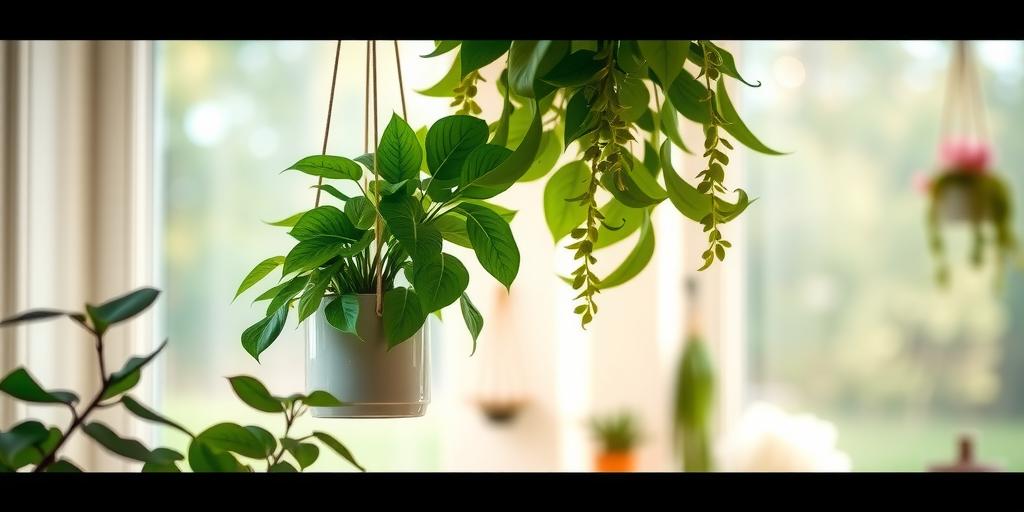
Purify Your Air: Best Hanging Plants for Cleaner Indoor Air in 2025
Discover the best hanging plants to purify your indoor air naturally! From spider plants to pothos, learn which air-purifying plants thrive indoors and how to care for them. Breathe easier with cleaner air today!
Introduction
Did you know indoor air can be up to 5 times more polluted than outdoor air? Thankfully, nature has a solution—hanging plants! These lush, trailing greens not only add beauty to your space but also filter out toxins, boost oxygen levels, and improve overall well-being. Whether you’re a busy urban dweller or a plant enthusiast, this guide will help you choose the best air-purifying hanging plants for a fresher, healthier home. Let’s dive in!
Why Hanging Plants Are Great for Air Purification
Hanging plants aren’t just beautiful—they’re also natural air purifiers. Many common houseplants absorb harmful toxins like formaldehyde and benzene, which can be found in furniture, cleaning products, and even the air we breathe. By incorporating hanging plants into your space, you’re not only adding greenery but also improving indoor air quality.
Vertical gardening is especially useful for small spaces. Since hanging plants don’t take up floor or shelf space, they’re perfect for apartments, offices, or any area where room is limited. Plus, they add a lush, layered look to your décor.
NASA’s Clean Air Study, conducted in the late 1980s, remains relevant today. The research identified several plants that effectively remove indoor pollutants. While modern air purifiers are great, plants offer a natural, cost-effective way to keep your air clean—and they look a lot prettier too!
Top 10 Air-Purifying Hanging Plants
Spider Plant – Removes Formaldehyde, Easy to Grow
Spider plants are one of the best choices for beginners. They thrive in indirect light and can tolerate occasional neglect. Plus, they’re excellent at removing formaldehyde, a common toxin found in household products.
Pothos (Devil’s Ivy) – Filters Benzene and Xylene, Low-Maintenance
Pothos is nearly indestructible, making it perfect for forgetful plant owners. It filters benzene and xylene, which are often present in paints and solvents. Its trailing vines look stunning in hanging baskets.
English Ivy – Reduces Airborne Mold, Perfect for Bathrooms
English Ivy is a powerhouse when it comes to purifying air. It’s particularly effective at reducing mold spores, making it an excellent choice for humid spaces like bathrooms.
Boston Fern – Humidifies Air, Removes Formaldehyde
Boston ferns act as natural humidifiers while also filtering formaldehyde. They love moisture, so they’re great for kitchens or bathrooms where humidity levels are higher.
String of Pearls – Unique Look, Filters Toxins
This quirky succulent isn’t just eye-catching—it also helps clean the air. Its bead-like leaves cascade beautifully, making it a stylish addition to any room.
Philodendron Heartleaf – Great for Beginners, Purifies Air Efficiently
Heartleaf philodendrons are forgiving and fast-growing. They’re excellent at removing indoor toxins and look gorgeous in hanging planters with their heart-shaped leaves.
Peperomia – Compact, Removes Multiple Pollutants
Peperomias come in many varieties, all of which are compact and easy to care for. They’re great at filtering out multiple pollutants without taking up much space.
Arrowhead Plant – Adaptable, Filters Common VOCs
Arrowhead plants are versatile and can thrive in various light conditions. They’re particularly good at removing volatile organic compounds (VOCs) from the air.
Lipstick Plant – Colorful Blooms, Improves Air Quality
If you want a pop of color, the lipstick plant delivers with its bright red flowers. Beyond its beauty, it also helps purify the air.
Hoya (Wax Plant) – Long-Lasting, Purifies While Adding Charm
Hoyas are known for their waxy leaves and fragrant blooms. They’re low-maintenance and effective at keeping the air clean, making them a great long-term choice.
How to Care for Your Air-Purifying Hanging Plants
Light Requirements for Each Plant
Different plants have different light needs. Spider plants and pothos do well in bright, indirect light, while English ivy and Boston ferns prefer medium to low light. String of pearls and hoyas need bright light but should be protected from harsh afternoon sun.
Watering Tips to Prevent Root Rot
Overwatering is a common mistake. Most hanging plants prefer their soil to dry out slightly between waterings. Boston ferns and English ivy like consistently moist soil, while succulents like string of pearls need less frequent watering. Always check the soil before adding water.
Best Soil and Fertilizer for Healthy Growth
A well-draining potting mix is essential to prevent root rot. For most hanging plants, a standard indoor potting mix works fine, but succulents and hoyas benefit from a grittier mix. Fertilize monthly during the growing season with a balanced liquid fertilizer diluted to half strength.
Common Pests and How to Avoid Them
Spider mites, mealybugs, and aphids can be a problem. Keep pests at bay by regularly inspecting your plants, wiping leaves with a damp cloth, and isolating any infected plants. Neem oil is a natural and effective treatment for most pests.
Best Places to Hang Your Plants for Maximum Air Purification
Ideal Spots: Living Rooms, Kitchens, Bathrooms, and Bedrooms
Living rooms and bedrooms benefit from air-purifying plants like spider plants and pothos. Kitchens and bathrooms, which often have higher humidity, are perfect for ferns and English ivy.
Avoiding Drafts and Direct Heat Sources
Keep plants away from air vents, radiators, and drafty windows, as extreme temperature changes can stress them. Instead, opt for stable environments where they can thrive.
Using Macramé Hangers, Wall Mounts, and Ceiling Hooks
Macramé hangers add a bohemian touch while keeping plants at eye level. Wall mounts and ceiling hooks are great for creating vertical gardens in small spaces. Just make sure your hooks can support the weight of the plant and pot.
DIY Tips: Make Your Own Hanging Planters
Upcycled Materials (Jars, Baskets, Ropes)
Get creative with upcycled materials! Old mason jars, woven baskets, or even repurposed ropes can be turned into charming planters. Just ensure proper drainage by adding holes or a layer of pebbles at the bottom.
Step-by-Step Guide for a Simple Macramé Hanger
-
Cut four equal lengths of cotton rope (about 8 feet each).
-
Fold them in half and knot them together at the top, leaving a loop for hanging.
-
Separate the strands into four pairs and tie knots about 6 inches down.
-
Repeat the knots further down for a layered look.
-
Gather all strands at the bottom and tie a final knot to secure your pot.
Creative Ways to Display Multiple Plants
Group several hanging plants at different heights for a lush, cascading effect. Use a wooden dowel or a tension rod to hang multiple planters in a row, or create a living wall with mounted shelves and trailing plants. The possibilities are endless!
Conclusion
Hanging plants are more than just décor—they’re natural air purifiers that bring life and freshness into your home. From the resilient spider plant to the elegant English ivy, there’s a perfect plant for every space and skill level. Ready to transform your indoor air quality? Start with one or two of these green wonders and watch your space—and health—bloom! Which plant will you try first? Share your favorites in the comments!
